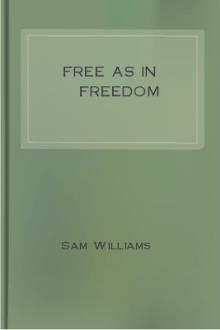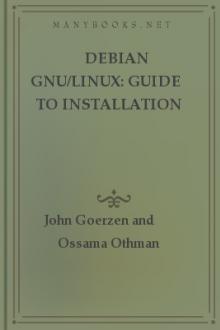Free as in Freedom by Sam Williams (ready to read books .TXT) 📕

- Author: Sam Williams
- Performer: 0596002874
Book online «Free as in Freedom by Sam Williams (ready to read books .TXT) 📕». Author Sam Williams
If you wish to incorporate parts of the Program into other free programs whose distribution conditions are different, write to the author to ask for permission.
For software that is copyrighted by the Free Software Foundation, write to the Free Software Foundation; we sometimes make exceptions for this. Our decision will be guided by the two goals of preserving the free status of all derivatives of our free software and of promoting the sharing and reuse of software generally.
“To compare something to a virus is very harsh,” says Stallman. “A spider plant is a more accurate comparison; it goes to another place if you actively take a cutting.”
For more information on the GNU General Public License, visit [http://www.gnu.org/copyleft/gpl.html.]
In an information economy increasingly dependent on software and increasingly beholden to software standards, the GPL has become the proverbial “big stick.” Even companies that once laughed it off as software socialism have come around to recognize the benefits. Linux, the Unix-like kernel developed by Finnish college student Linus Torvalds in 1991, is licensed under the GPL, as are many of the world’s most popular programming tools: GNU Emacs, the GNU Debugger, the GNU C Compiler, etc. Together, these tools form the components of a free software operating system developed, nurtured, and owned by the worldwide hacker community. Instead of viewing this community as a threat, high-tech companies like IBM, Hewlett Packard, and Sun Microsystems have come to rely upon it, selling software applications and services built to ride atop the ever-growing free software infrastructure.
They’ve also come to rely upon it as a strategic weapon in the hacker community’s perennial war against Microsoft, the Redmond, Washington-based company that, for better or worse, has dominated the PC-software marketplace since the late 1980s. As owner of the popular Windows operating system, Microsoft stands to lose the most in an industry-wide shift to the GPL
license. Almost every line of source code in the Windows colossus is protected by copyrights reaffirming the private nature of the underlying source code or, at the very least, reaffirming Microsoft’s legal ability to treat it as such. From the Microsoft viewpoint, incorporating programs protected by the “viral” GPL
into the Windows colossus would be the software equivalent of Superman downing a bottle of Kryptonite pills. Rival companies could suddenly copy, modify, and sell improved versions of Windows, rendering the company’s indomitable position as the No. 1 provider of consumer-oriented software instantly vulnerable. Hence the company’s growing concern over the GPL’s rate of adoption. Hence the recent Mundie speech blasting the GPL and the ” open source” approach to software development and sales. And hence Stallman’s decision to deliver a public rebuttal to that speech on the same campus here today.
20 years is a long time in the software industry.
Consider this: in 1980, when Richard Stallman was cursing the AI Lab’s Xerox laser printer, Microsoft, the company modern hackers view as the most powerful force in the worldwide software industry, was still a privately held startup. IBM, the company hackers used to regard as the most powerful force in the worldwide software industry, had yet to to introduce its first personal computer, thereby igniting the current low-cost PC market. Many of the technologies we now take for granted-the World Wide Web, satellite television, 32-bit video-game consoles-didn’t even exist. The same goes for many of the companies that now fill the upper echelons of the corporate establishment, companies like AOL, Sun Microsystems, Amazon.com, Compaq, and Dell. The list goes on and on.
The fact that the high-technology marketplace has come so far in such little time is fuel for both sides of the GPL debate. GPL-proponents point to the short lifespan of most computer hardware platforms. Facing the risk of buying an obsolete product, consumers tend to flock to companies with the best long-term survival.
As a result, the software marketplace has become a winner-take-all arena.See Shubha Ghosh, “Revealing the Microsoft Windows Source Code,” Gigalaw.com (January, 2000).
http://www.gigalaw.com/articles/ghosh-2000-01-p1.html The current, privately owned software environment, GPL-proponents say, leads to monopoly abuse and stagnation. Strong companies suck all the oxygen out of the marketplace for rival competitors and innovative startups.
GPL-opponents argue just the opposite. Selling software is just as risky, if not more risky, than buying software, they say. Without the legal guarantees provided by private software licenses, not to mention the economic prospects of a privately owned “killer app” (i.e., a breakthrough technology that launches an entirely new market),Killer apps don’t have to be proprietary. Witness, of course, the legendary Mosaic browser, a program whose copyright permits noncommercial derivatives with certain restrictions. Still, I think the reader gets the point: the software marketplace is like the lottery. The bigger the potential payoff, the more people want to participate. For a good summary of the killer-app phenomenon, see Philip Ben-David, “Whatever Happened to the `Killer App’?” eCommerce News (December 7, 2000).
companies lose the incentive to participate. Once again, the market stagnates and innovation declines. As Mundie himself noted in his May 3 address on the same campus, the GPL’s “viral” nature “poses a threat” to any company that relies on the uniqueness of its software as a competitive asset. Added Mundie: It also fundamentally undermines the independent commercial software sector because it effectively makes it impossible to distribute software on a basis where recipients pay for the product rather than just the cost of distributionSee Craig Mundie, “The Commercial Software Model,”
senior vice president, Microsoft Corp. Excerpted from an online transcript of Mundie’s May 3,speech to the New York University Stern School of Business.
http://www.ecommercetimes.com/perl/story/5893.html 001, http://www.microsoft.com/presspass/exec/craig/05-03sharedsource.asp The mutual success of GNU/ LinuxThe acronym GNU stands for “GNU’s not Unix.”
In another
portion of the May 29, 2001, NYU speech, Stallman summed up the acronym’s origin: We hackers always look for a funny or naughty name for a program, because naming a program is half the fun of writing the program. We also had a tradition of recursive acronyms, to say that the program that you’re writing is similar to some existing program … I looked for a recursive acronym for Something Is Not UNIX. And I tried all 26
letters and discovered that none of them was a word. I decided to make it a contraction. That way I could have a three-letter acronym, for Something’s Not UNIX. And I tried letters, and I came across the word “GNU.” That was it. Although a fan of puns, Stallman recommends that software users pronounce the “g” at the beginning of the acronym (i.e., “gah-new”). Not only does this avoid confusion with the word “gnu,” the name of the African antelope, Connochaetes gnou , it also avoids confusion with the adjective “new.” “We’ve been working on it for 17 years now, so it is not exactly new any more,” Stallman says. Source: author notes and online transcript of “Free Software: Freedom and Cooperation,”
Richard Stallman’s May 29, 2001, speech at New York University.
http://www.gnu.org/events/rms-nyu-2001-transcript.txt , the amalgamated operating system built around the GPL-protected Linux kernel, and Windows over the last 10 years reveals the wisdom of both perspectives.
Nevertheless, the battle for momentum is an important one in the software industry. Even powerful vendors such as Microsoft rely on the support of third-party software developers whose tools, programs, and computer games make an underlying software platform such as Windows more attractive to the mainstream consumer.
Citing the rapid evolution of the technology marketplace over the last 20 years, not to mention his own company’s admirable track record during that period, Mundie advised listeners to not get too carried away by the free software movement’s recent momentum: Two decades of experience have shown that an economic model that protects intellectual property and a business model that recoups research and development costs can create impressive economic benefits and distribute them very broadly. Such admonitions serve as the backdrop for Stallman’s speech today. Less than a month after their utterance, Stallman stands with his back to one of the chalk boards at the front of the room, edgy to begin.
If the last two decades have brought dramatic changes to the software marketplace, they have brought even more dramatic changes to Stallman himself. Gone is the skinny, clean-shaven hacker who once spent his entire days communing with his beloved PDP-10. In his place stands a heavy-set middle-aged man with long hair and rabbinical beard, a man who now spends the bulk of his time writing and answering email, haranguing fellow programmers, and giving speeches like the one today.
Dressed in an aqua-colored T-shirt and brown polyester pants, Stallman looks like a desert hermit who just stepped out of a Salvation Army dressing room.
The crowd is filled with visitors who share Stallman’s fashion and grooming tastes. Many come bearing laptop computers and cellular modems, all the better to record and transmit Stallman’s words to a waiting Internet audience. The gender ratio is roughly 15 males to 1
female, and 1 of the 7 or 8 females in the room comes in bearing a stuffed penguin, the official Linux mascot, while another carries a stuffed teddy bear.
<Graphic file:/home/craigm/books/free_0201.png>
Richard Stallman, circa 2000. “I decided I would develop a free software operating system or die trying . . of old age of course.” Photo courtesy of http://www.stallman.org.
Agitated, Stallman leaves his post at the front of the room and takes a seat in a front-row chair, tapping a few commands into an already-opened laptop. For the next 10 minutes Stallman is oblivious to the growing number of students, professors, and fans circulating in front of him at the foot of the auditorium stage.
Before the speech can begin, the baroque rituals of academic formality must be observed. Stallman’s appearance merits not one but two introductions. Mike Uretsky, codirector of the Stern School’s Center for Advanced Technology, provides the first.
“The role of a university is to foster debate and to have interesting discussions,” Uretsky says. “This particular presentation, this seminar falls right into that mold. I find the discussion of open source particularly interesting.”
Before Uretsky can get another sentence out, Stallman is on his feet waving him down like a stranded motorist.
“I do free software,” Stallman says to rising laughter.
“Open source is a different movement.”
The laughter gives way to applause. The room is stocked with Stallman partisans, people who know of his reputation for verbal exactitude, not to mention his much publicized 1998 falling out with the open source software proponents. Most have come to anticipate such outbursts the same way radio fans once waited for Jack Benny’s trademark, “Now cut that out!” phrase during each radio program.
Uretsky hastily finishes his introduction and cedes the stage to Edmond Schonberg, a professor in the NYU
computer-science department. As a computer programmer and GNU Project contributor, Schonberg knows which linguistic land mines to avoid. He deftly summarizes Stallman’s career from the perspective of a modern-day programmer.
“Richard is the perfect example of somebody who, by acting locally, started thinking globally [about]
problems concerning the unavailability of source code,”
says Schonberg. “He has developed a coherent philosophy that has forced all of us to reexamine our ideas of how software is produced, of what intellectual property means, and of what the software community actually represents.”
Schonberg welcomes Stallman to more applause. Stallman takes a moment to shut off his laptop, rises out of his chair, and takes the stage.
At first, Stallman’s address seems more Catskills comedy routine than political speech. “I’d like to thank Microsoft for providing me the opportunity to be on this platform,” Stallman wisecracks. “For the past few weeks, I have felt like an author whose





Comments (0)